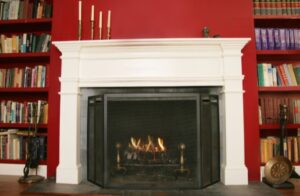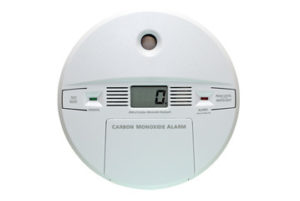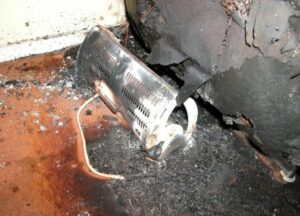Home Heating Safety Tips
 It’s that time of the year when the onset of cooler weather induces homeowners to seek alternative and economical methods of keeping warm. The increase in the use of home heating appliances also increases the risk of home heating fires; the second leading cause of U.S. home fires resulting in four out of the five home fire injuries and nearly nine out of ten deaths.
It’s that time of the year when the onset of cooler weather induces homeowners to seek alternative and economical methods of keeping warm. The increase in the use of home heating appliances also increases the risk of home heating fires; the second leading cause of U.S. home fires resulting in four out of the five home fire injuries and nearly nine out of ten deaths.
Prince William County Fire and Rescue System Chief Tom LaBelle urges residents to be vigilant when using alternative heating methods by following these simple safety tips to keep you and your loved ones safe and warm:
FIREPLACES, WOOD STOVES, AND OTHER FUEL-FIRED APPLIANCES
Fires that originate from these appliances are referred to as “confined” fires. Wood stoves, the most popular category of wood-burning heaters, causes thousands of residential fires each year. Be sure to:
- Install wood burning stoves following manufacturer’s instructions or have a professional do the installation.
- Keep fireplaces and wood stoves clean.
- Clean annually by a certified chimney specialist.
- Keep the area around the fireplace and woodstove clean and free of debris, decorations, and flammable materials.

- ALWAYS use a metal or heat-tempered glass screen with fireplaces.
- Install spark screens and caps on chimneys.
- Install stovepipe thermometers to monitor flue temperatures.
- Keep air inlets open on wood stoves and fireplaces.
- If closed, inlets cause creosote buildup and lead to chimney fires.
- Certain types of wood, like soft moist wood, increase creosote buildup.
- Build small fires that burn completely and produce less smoke.
- NEVER leave a fire unattended in a fireplace.
Safely Burn Fuels
- NEVER use flammable liquids to start a fire.
- Use only seasoned wood.
- Extinguish fire before leaving the house or going to bed.
- When removing fireplace ashes precautions should be taken to prevent fires or injuries:
- Wear heavy leather gloves when cleaning embers and ashes out of your fireplace or wood burning stove to protect your hands from any hot embers.
- DO NOT place woodstove or fireplace ashes in paper bags or any other combustible container.
- Dispose of embers and ashes in a metal container with a lid. (Remember, ashes can remain hot for several days so they should be stored on a noncombustible surface or spread out on the ground at least 10 feet away from your home and any nearby building or combustible material.)
PORTABLE or SPACE HEATERS
Kerosene Heaters
- Buy only Underwriter’s Laboratory/UL-approved heaters.
- NEVER fill your heater with gasoline or camp stove fuel.
- Both flareup easily and increase the risk of fire.
- Use only fuels appropriate for appliances.
- Refuel outside and only after heater has cooled.
- DO NOT use kerosene heaters in small, enclosed areas.

- Potential for carbon monoxide (CO) poisoning.
- A person can be poisoned by a small amount of CO over a long period of time or by a large amount of CO over a shorter amount of time.
- Install and maintain CO alarms to avoid the risk of CO poisoning.
- Potential for carbon monoxide (CO) poisoning.
- When using, keep a window ajar or the door open.
- Annually, clean kerosene heaters and replace wicks.
 Electric Space Heaters
Electric Space Heaters
- Space heaters account for one third of home heating fires that result in the majority of deaths and injuries in home fires caused by heating equipment.
- Buy only heaters with Underwriter’s Laboratory (UL) safety listing.
- Be sure it has a thermostat control mechanism and automatically switches off if tipped over.
- ALWAYS unplug when leaving the room or going to bed.
- Avoid using extension cords.
- NEVER use frayed or damaged cords.
Whether you’re using a stationary or portable heating appliance:
- Keep anything that can burn at least 3 feet away from heating equipment, such as the furnace, fireplace, wood stove, or portable space heater.
- According to NFPA’s Home Heating Fires (December 2022) fires in which the heat source was too close to combustibles were associated with the largest number of injuries, deaths, and property damage.
- Have a three-foot “kid-free zone” around open fires and space heaters.
- NEVER use your oven to heat your home.
- Remember to turn portable heaters off when leaving the room or going to bed.
To significantly increase your chances of surviving a fire in your home — by more than double — install smoke alarms and sprinklers in the home. In addition, develop and practice a home fire escape plan and be sure everyone residing in your home is familiar with the plan.
For additional information regarding home heating safety, visit the National Fire Protection Association and the U.S. Fire Administration.
For additional information on home structure fires, visit NFPA’s Home Structure Fires (April 2023) and Fire Loss in the United States During 2021 (September 2022).